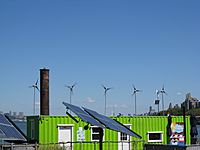Science Barge facts for kids
The Science Barge is a special floating farm and learning center. It has been in Yonkers, New York since late 2008. This amazing barge grows plants using a method called hydroponics. This means plants grow in water, not soil!
The Science Barge gets its power from clean energy sources. It uses solar panels, wind turbines, and special fuels called biofuels. The plants get water from captured rainwater and river water that has been cleaned. This way, food is grown without creating pollution or using harmful chemicals.
The Science Barge is also a place for people to learn. School groups from Westchester, New York City, and nearby areas visit during the week. On weekends, anyone can visit and learn about sustainable farming. From 2006 to 2008, the barge traveled along the Manhattan waterfront. It stopped at six different places to teach people about growing food in cities.
In 2015, Nathalie Manzano-Smith and Ted Caplow won a special grant. They used it to build a Miami Science Barge. This new barge opened on Earth Day, April 22, 2016, in Museum Park in downtown Miami, FL. In April 2017, the Miami Science Barge was given to the Frost Science Museum. The Miami barge focuses more on ocean science and growing seafood. It also has updated farming systems.
How the Science Barge Started
The idea for the Science Barge came from Ted Caplow. It was built by New York Sun Works, a group that teaches about science. They wanted to show students and teachers how to grow food in a way that helps the environment. This is called sustainability.
The Science Barge floats on a large steel boat. This boat is about 115 feet long. It was built in the 1940s and used to carry cargo in New York Harbor. New York Sun Works leased the boat in 2006. The special farming systems were built on the barge in Brooklyn during the summer of 2006.
The Science Barge first opened to the public on May 4, 2007. It was docked at Pier 84 in Manhattan. This was near the Circle Line Sightseeing Cruises and the Intrepid Sea-Air-Space Museum. For the next two years, the barge also visited other piers in Manhattan.
Moving to Yonkers
After touring for two years, New York Sun Works looked for a permanent home. In October 2008, they sold the Science Barge to Groundwork Hudson Valley for just $2.00. Groundwork Hudson Valley is a group that helps communities in the lower Hudson Valley. They focus on making sure everyone has a healthy environment.
In November 2008, the Science Barge moved to 99 Dock Street in Yonkers, NY. This spot is at the mouth of the Saw Mill River. Being in Yonkers has helped bring many visitors to the downtown area. It's easy to get to by public transportation.
The barge's location by the Saw Mill River also helps people notice the river's restoration work. This helps the downtown Yonkers area continue to improve. Groundwork Hudson Valley uses the Science Barge for many food programs. These include the Get Fresh Yonkers Food Co-op and a Farmers Market. They also have a Community-Supported Agriculture (CSA) program.
How the Barge Works
The greenhouse on the barge is about 1200 square feet. It was bought new and built right on the boat. The greenhouse walls are made of glass. The roof is a strong, double-layered plastic.
To keep the plants cool, the greenhouse has fans and a special cooling system. It also has a large roof vent that opens automatically. This helps fresh air move through the greenhouse naturally. Rainwater is collected from the roof and stored in tanks. These tanks can hold 1200 gallons of water. This water is then used to water the hydroponic plants.
The barge has tried many different ways to grow plants. It has also hosted experiments with aquaponics. This is a system that combines raising fish with growing plants. They have grown fish like tilapia and catfish. They have also grown crayfish, clams, and oysters.
The barge's original energy system was very advanced. It had solar panels that could produce 2.5 kilowatts of power. It also had small micro wind turbines that made 2 kilowatts of power. For backup, there was a 4-kilowatt generator that ran on biodiesel. A large battery bank stored energy for the barge. The barge also had a special system to clean water from the Hudson River. This system, called reverse osmosis, turned river water into fresh water for the plants.




